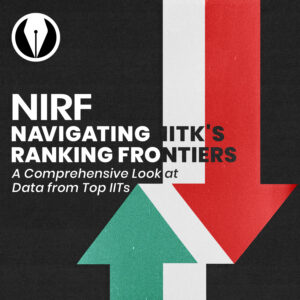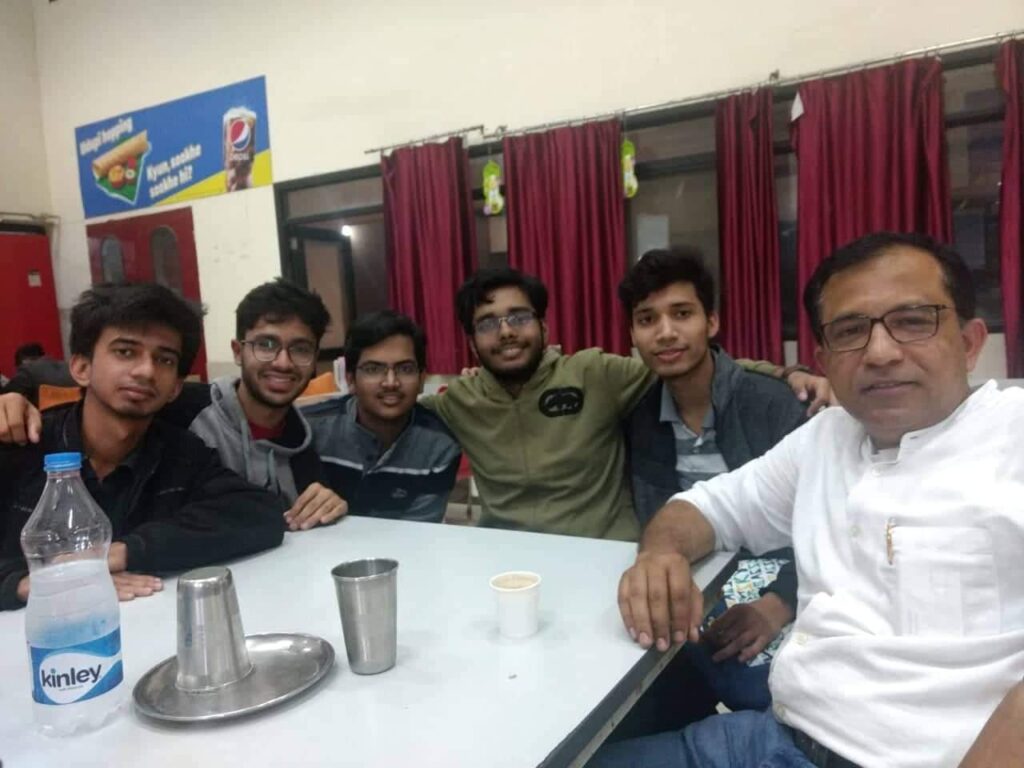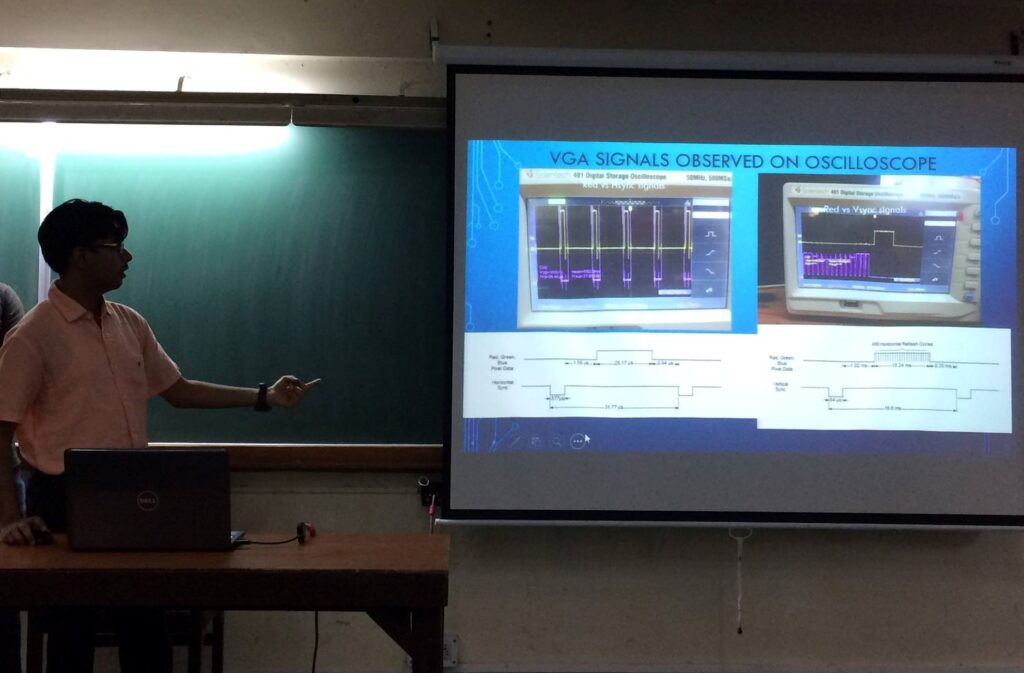Nitish Vikas Deshpande is a Y17 graduating student from the Department of Electrical Engineering. He talks about his experience with his curriculum and his research interests with a sweet taste of Electrical Engineering.
Disclaimer:- The views presented below are the author’s own and are not in any manner representative of the views of Vox Populi as a body or IIT Kanpur in general. This is an informal account of the author’s experiences at IIT-K.
From the title of this blog, you must have deduced that I am graduating from electrical engineering (In electrical engineering, the imaginary unit is normally denoted by j instead of i, because i is commonly used to denote electric current). Today, I have completed 2.75 + 1.25 j years at IIT Kanpur. Although the overall magnitude of the phasor reduced from 4 to 3.02, the imaginary part of my stay here created a positive phase shift and aligned me in the right direction. The pandemic has shown us that life is not purely resistive but also has a reactive component which results in a complex impedance. We have to “match” this complex impedance that the pandemic has brought in our lives. My journey at IITK and through electrical engineering has been phenomenal. IITK provided me with a huge bandwidth to explore my interests during the 2.75 years and a large reconfigurable antenna array for beamforming my efforts and overcoming the uncontrollable blockages during the 1.25 years of the pandemic. By now, some of you must have figured out the significance of these jargons from electrical engineering. For the past few months, I have been writing a journal paper for submission to Wireless Transactions. I wrote this article in the same duration. I found resemblance between mathematical models in wireless systems to the student life at IITK. I present some of these wireless models in my article and relate it to my IITK journey.
The path of a student from Sem 1 to Sem 8 is like a multipath wireless channel with infinitely many routes from source to destination. In one’s journey, one will experience many scatterers which may create both constructive or destructive interference. The scatterers in your journey may be your student guide, Counselling Service family, friends’ circle in your wing, clubs/hobby groups, department; seniors, juniors and batchmates; your course instructors, UGP advisor, sometimes even IITK alumni. I experienced many rich scatterers. One of my first scatterers is my student guide who is also an EE graduate. He helped me in the smooth transition to campus life. I developed a strong rapport with him. We even shared some common EE courses. He was also my lab partner in the EE381 lab (although we couldn’t complete the project component of the EC lab due to the closure of Spring 20 semester). My next rich scattering environment was provided by the Electronics Club of IITK. I was first introduced to the E-club during my orientation. I remember being fascinated by the “Brain-Computer Interface” project in Orientation’ 17 presented by a Y16 Eclub secy. He later became a very close friend and also my collaborator in the first industrial project of the SnT council with Broadcast Audience Research Council (BARC). During my first year, I met some of my best friends at Takneek Electromania, Eclub winter camp, and summer camp. Some of them became my fellow coordinators in my third year. Being a part of the Eclub family and the SnT council opened several opportunities for me.

I participated in three editions of INTER IIT Tech Meet, and international competitions like DJI Robomasters and IEEE Signal Processing Cup challenge. I also had an opportunity to conduct institute-wide lectures that helped me develop public speaking skills. During my tenure as E-club coordinator, I was lucky to interact with the founder of E-club, Mohan Tambe, who had visited IITK and Eclub during the 1980 batch reunion.

He had founded E-club with the vision that the students retain the knowledge that they gain by doing hands-on work. I was also lucky to interact with Dr. Sumit Chowdhury (EE graduate from 1992) during my first techmeet at IITB. He, a technology advisor to BARC, was a member of the evaluation panel who approached our team at the end of our presentation and asked “Which Hall, guys?”. The interaction with him during techmeet became a one year long collaboration with BARC. He even met us a year later in Hall 12 canteen where he shared experiences from his undergraduate days.
To summarize, the E-club is where I made some of the best friends at IITK and connected with some influential alumni, who influenced my personality and provided me with a plethora of opportunities to explore my interests. I still have some pending projects/ideas at E-club which had to be discontinued due to the pandemic. I hope that the future generation in E-club will work on those ideas and revive the culture of E-club!
The third rich scattering environment was the Electrical Engineering department of IITK. The EE Department of IITK is one of the most active research hubs in the world. My research journey began with working on a project in music information retrieval (MIR) with Prof. Vipul Arora. Like many others from my batch, I had decided to pursue a research project via the SURGE program for undergraduate research. Although this project did not lead to any significant output in terms of publication, I got an opportunity to grasp the fundamental concepts in signal processing and machine learning. I also became familiar with the methodology of conducting research. I developed a strong rapport with Prof. Arora. He also encouraged me to attend an audio processing workshop at IITB in my 5th semester, where I connected with some of the pioneers in MIR, like Prof. Mueller and Prof. Serra. Interacting with them helped me develop an interest in pursuing a career in academic research.

Around the same time, I had developed an inclination towards wireless communication theory. During the Eclub project on Witrack, I and my team got preliminary exposure to software-defined radios (SDR). We had built a miniature Frequency Modulated Carrier Wave RADAR using the hardware components in Prof. A R Harish’s Microwave Lab. The DC course on communication theory, EE320, further boosted my interest. I had also attended a talk by Dr. Ing Habil Ulrich L. Rohde, a pioneer in radio frequency and microwave technology, organized at IITK as a part of the Institute Diamond Jubilee Lecture series. In this talk, I met a Y15 EE senior, who had also worked on SDR previously during his internship at UCSD. Connecting with him has been a very important part of my academic journey. He has been a very influential senior who helped me shape my career path. I later had an opportunity to record a podcast with him on “5G and Beyond”.
Till now, my journey would have seemed to you like a smooth ride without any obstacles. However, just like the direct link between receiver and transmitter in a wireless communication system is blocked by obstacles, my path got blocked by the COVID pandemic. Many of my friends had secured good corporate internships during the intern season in the 5th semester. Since I was interested in pursuing graduate studies after B.Tech, I had decided to not apply for corporate internships via SPO. I had started applying for research internships. At the end of November 2019, I had secured an internship at Texas A&M University with a professor who worked in the area of deep reinforcement learning. I had also secured another research internship opportunity at New York University Tandon School of Engineering in the area of wireless communication networks. However, both internships had to be rescinded due to the COVID pandemic. I received notification of the rescindment in late March. I did not have any other backup plan for summers. Some of my batchmates also faced a similar obstacle. I will now describe my journey through the pandemic by first presenting a similar situation in wireless communication and the technology envisioned by the academic community to overcome this problem. I will then propose to apply this wireless model to the IITK student’s model.
The wireless propagation environment is often uncontrollable because of the presence of random blockages which cause heavy attenuation of the signal from transmitter to the receiver. Recently, the wireless community has proposed a new technology called the intelligent reflecting surface (IRS).

Model of intelligent reflecting surface in IITK context (Original Picture from “Towards Smart and Reconfigurable Environment: Intelligent Reflecting Surface Aided Wireless Network” by Rui Zhang et al.)
An IRS is made up of several elements called reflecting elements (RE) which can modify the wireless propagation environment by passively creating phase shifts in the incoming signal and beamforming it towards the receiver. Now, I apply this concept to the IITK model. Consider yourself as the base station (BS) who wants to achieve a particular goal but cannot do so, as the direct path is blocked by the pandemic. I propose to apply the concept of the IRS which can create a phase shift and take you along a different path to reach your destination. The IRS here refers to a collection of individuals (RE) from the IITK community who will passively influence your decisions and take you along a different path to reach your destination. This group of individuals won’t let your signal strength attenuate because of the obstacle. Every student will require a different set of individuals to influence his path based on the nature of the obstacle. For eg, a student who is in depression would require help from the counselling service. A student who is in need of career guidance would take help from the academics and career council representative. A student who requires financial assistance will reach out to the DOSA representative. The student would need to ask for help and get in touch with many such individuals who will provide an alternate route to reach the destination. Note that it is the base station which controls the phase shifts of each reflecting element of the IRS. So, it is entirely up to the student to reach out to those individuals who would be willing to help him. I would like to quote the famous line by the Hogwarts Headmaster Albus Dumbledore which is relevant in the IITK context, “Help will always be given at IITK to those who ask for it.”
Coming back to my story, after the announcement of the rescinding of my research internship in summer 2020, I had started looking out for alternative opportunities. Some of my friends, who were in a similar situation, decided to postpone their graduation plans by converting to a dual degree and stay back another year at IITK working on a Master’s thesis. After consulting some Y14 and Y15 EE seniors, I decided that I will continue with my pre-pandemic goals of applying for graduate school. I knew that applying for graduate school for Fall 21 semester was going to be super competitive given the pandemic and since many students from Fall 20 had to defer admits to Fall 21. I decided to take up this challenge and utilize the five months vacation (April-August) for building a good research profile. In 6th sem, I had opted for the elective course on stochastic geometry based analysis of wireless networks by Prof. Abhishek Gupta. I decided to continue working on the term project of that course with my batchmate who was the only other UG student in that course. Fortunately, Prof. Gupta was very cooperative and mentored us to work further on that topic. After multiple discussions via mail, we finally got some good results and decided to submit our work to the IEEE ANTS conference. This paper got accepted in November 2020, and I presented the paper at the virtual ANTS 20 conference. In May 2020, I attended the virtual ICASSP conference. I came across the concept of intelligent reflecting surfaces (IRS) which I had described earlier. I approached Prof. Rohit Budhiraja and expressed my interest in working on a problem related to the IRS. I am fortunate that Prof Budhiraja welcomed me in his group. I continued working on the problem for the 7th and 8th sem for my UGP and am currently writing a journal paper. At the end of September 2020, I had to make a decision whether to apply for MS or Ph.D. Fortunately, Prof. Abhishek Gupta had posted about a Ph.D. opening in Prof. Robert Heath’s group. I was excited by this news and decided to put in more effort to make a good Ph.D. application. I am thankful for the guidance and support provided by my mentors in my research work. A few weeks after the application, I received an email from Prof. Heath stating that he found my application phenomenal and would be happy to have me work under his supervision. I feel very grateful to have received an email from Prof. Heath, who is a pioneer in the field of MIMO communications. The key takeaway from my story is to not let the obstacles stop you from pursuing your dreams. Instead, one should take help from the IITK community which will provide an alternate route to realize your dreams. In my journey, my batchmates, seniors, and professors from EE were the key reflecting elements which beamformed me towards my goal.
Pilot training is a key stage in any wireless communication system. A pilot sequence is a known sequence and the BS estimates the channel by using the received pilot symbols transmitted by the user. After learning the channel environment, the BS then designs its beamforming vector.
In the IITK student’s model, the pilot sequence transmitted by the user can refer to the experiences shared by the seniors. Learning from the experiences of others can save us a lot of time so that we can avoid committing the same mistakes. Based on these experiences, the student can then decide to beamform his efforts in the right direction and avoid paths with heavy attenuation.
For the past year, we all have been away from the busy life of campus due to the pandemic. Here, I would like to inform you that this is not the first time that students have been forced to stay away from university life due to unforeseen circumstances. A few centuries ago, Isaac Newton was in his early 20s when the Great Plague of London hit. Cambridge sent students home to continue their studies. Freed from the restrictions of the limited curriculum and rigours of university life, Newton had the time and space to develop his theories on calculus, optics and the laws of motion and gravity.
We all should take inspiration from Newton who also worked from home (WFH). He would say about this forced time away from university life: ‘For in those days I was in the prime of my age for invention & minded Mathematics & Philosophy more than at any time since.’” My definition of WFH is a bit different. I call it the XFY. Here, X is not just restricted to work. For me, X stands for exploration. The Zoom era has enabled us to explore the world. My favourite part is that I have been able to attend numerous virtual conferences and interact with researchers all over the world via zoom. Many professors have also provided access to lecture recordings. We should utilize this opportunity to gain knowledge in highly specialized areas. Here, Y is not limited to the study table at your home. It can be almost any place with internet connectivity. Last week, I witnessed an extreme example of Y during the virtual ICC 2021 conference from Prof. Rappaport who participated in the fireside chat with Prof. Heath while driving down the interstate highway.
IITK provided me with the gift of knowledge and intellect in a very specialized area within a short span of time. It also provided me with an excellent set of friends to share this gift. The EE curriculum at IITK taught me about the major discoveries and inventions ranging from the Fourier Transform in 1822, Maxwell’s equation in 1865, Claude Shannon’s seminal work on “Mathematical Theory of Communication” in 1948, and last but not the least about Thomas Marzetta’s seminal work on Massive MIMO in 2010. Today, I am about to start a new chapter in my life by standing on the shoulders of these four giants in EE to pursue research at the intersection of signal processing, electromagnetic theory, information theory, and wireless communications. Today, as an electrical engineer, I find myself in a unique position to create a positive impact in the world.
Written by: Nitish Vikas Deshpande
Edited by: Pradeep Suresh, Aryan Pandeya















